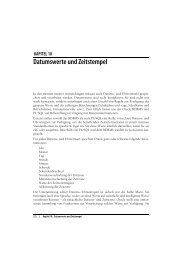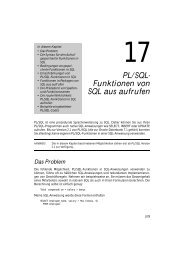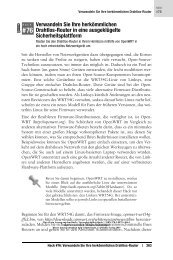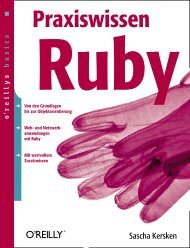Table of Contents
Table of Contents
Table of Contents
You also want an ePaper? Increase the reach of your titles
YUMPU automatically turns print PDFs into web optimized ePapers that Google loves.
7<br />
Better<br />
Living in Objectville<br />
Plan your programs with the future in mind. What if you could write<br />
code that someone else could extend, easily? What if you could write code that was flexible,<br />
for those pesky last-minute spec changes? When you get on the Polymorphism Plan, you’ll<br />
learn the 5 steps to better class design, the 3 tricks to polymorphism, the 8 ways to make<br />
flexible code, and if you act now—a bonus lesson on the 4 tips for exploiting inheritance.<br />
Make it Stick<br />
Roses are red, violets are blue.<br />
Square IS-A Shape, the reverse isn’t true.<br />
Roses are red, violets are dear.<br />
Beer IS-A Drink, but not all drinks are beer.<br />
OK, your turn. Make one that shows the oneway-ness<br />
<strong>of</strong> the IS-A relationship. And remember,<br />
if X extends Y, X IS-A Y must make sense.<br />
Understanding inheritance (superclass and subclass relationships) 168<br />
Designing an inheritance tree (the Animal simulation) 170<br />
Avoiding duplicate code (using inheritance) 171<br />
Overriding methods 172<br />
IS-A and HAS-A (bathtub girl) 177<br />
What do you inherit from your superclass? 180<br />
What does inheritance really buy you? 182<br />
Polymorphism (using a supertype reference to a subclass object) 183<br />
Rules for overriding (don’t touch those arguments and return types!) 190<br />
Method overloading (nothing more than method name re-use) 191<br />
Exercises and puzzles 192<br />
8<br />
Serious<br />
Polymorphism<br />
Inheritance is just the beginning. To exploit polymorphism, we need<br />
interfaces. We need to go beyond simple inheritance to flexibility you can get only by<br />
designing and coding to interfaces. What’s an interface? A 100% abstract class. What’s an<br />
abstract class? A class that can’t be instantiated. What’s that good for? Read the chapter...<br />
Object o = al.get(id);<br />
Dog d = (Dog) o;<br />
d.bark();<br />
o<br />
Object<br />
d<br />
Dog<br />
Object<br />
Dog object<br />
cast the Object<br />
back to a Dog we<br />
know is there.<br />
Some classes just should not be instantiated 200<br />
Abstract classes (can’t be instantiated) 201<br />
Abstract methods (must be implemented) 203<br />
Polymorphism in action 206<br />
Class Object (the ultimate superclass <strong>of</strong> everything) 208<br />
Taking objects out <strong>of</strong> an ArrayList (they come out as type Object) 211<br />
Compiler checks the reference type (before letting you call a method) 213<br />
Get in touch with your inner object 214<br />
Polymorphic references 215<br />
Casting an object reference (moving lower on the inheritance tree) 216<br />
Deadly Diamond <strong>of</strong> Death (multiple inheritance problem) 223<br />
Using interfaces (the best solution!) 224<br />
Exercises and puzzles 230<br />
xiii

















